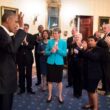IF YOU OWN A reasonably balanced asset portfolio, there’s good news. Stock prices continue to climb in a post-New Year rally. Your recession is over.
If you’re a working stiff, the news is not so good. There are 50 percent fewer job opportunities today than there were at the recent job-market peak in 2007. Your depression persists.
Since 2007, when a housing boom fueled by subprime mortgage loans created unsustainable economic growth, job openings have fallen by 2.3 million, according to the Bureau of Labor Statistics. That decline leaves 2.4 million available jobs for the 15.7 million Americans looking for work today.
That’s roughly 6.5 unemployed workers for each available job. Compare that to 1.7 unemployed workers for each available job in December 2007, when the recession began. (Republicans running for House and Senate seats in November certainly will.) For the unemployed, and for workers whose salaries are depressed by a 10.6 percent unemployment rate, George W. Bush’s recession is Barack Obama’s depression.
Democrats will lose some seats in Congress in 2010. Republican candidates can leverage those losses by reminding voters how good employment numbers were when George W. Bush was president. (The fact that the recession was a result of Bush policies won’t matter.)
Democrats have arrived at one of those moments where good policy is good politics. They can address the unemployment crisis by passing a jobs bill that would start putting people back to work before the November 2010 elections. By doing so, they can stanch the November losses.
Don’t count on them to seize the moment.
The president stood on the sidelines and watched the final House vote in December—a $154 billion jobs bill that passed only because Speaker Nancy Pelosi willed it. (Pelosi whipped the bill herself, working the floor for an hour before the vote, and made a floor speech supporting it.) The Jobs for Main Street bill passed by a 217-212 vote, without the support of a single Republican. Thirty-eight Democrats voted against it. In February the bill will be taken up by the Senate, where the odds are not good, unless the White House gets behind it.
The bill is at best a modest proposal. “It’s just too small,” said Heidi Shierholz, an economist at the Economic Policy Institute (EPI) in Washington. “Back of the envelope,” Shierholz said, “$100 billion in spending will get you roughly a million jobs. So $150 million [in the House bill] is not going to get us where we need to be.”
Shierholz said the National Bureau of Economic Research will probably date the end of the recession as July or August of 2009. “We’re several months out of the recession and we’re still losing 85,000 jobs a month,” she said. “It’s beginning to sink in that we’re not in a jobless recovery but a job-loss recovery.” To get employment to pre-recession levels would require the creation of 10.6 million jobs.
A REASONABLE PROPOSITION—In December, the EPI published a job-creation plan that makes the case for spending $400 billion to create 4.6 million jobs. It includes:
- budget relief for states to prevent further layoffs of teachers, police officers, firefighters, and other public sector employees, which create a ripple effect beyond the public sector as the unemployed stop spending;
- funding for transportation, and for rehabilitating the nation’s public school buildings, which would provide 240,000 jobs for 1.5 million unemployed construction workers;
- funding for temporary public service jobs;
- funding for extended unemployment insurance and health insurance for people who have lost their jobs (and their employer-provided health insurance);
- a temporary job-creation tax credit for employers who hire new workers.
Considering what was required to get $154 billion in jobs spending through the House, passing such a bill would require an FDR moment for Barack Obama. Not, however, the FDR moment that worriesNew York Times columnist (and Nobel Prize economist) Paul Krugman: 1937, when Roosevelt put the breaks on spending and allowed the economy to slide back into a recession. That’s the policy course that would be charted by the Robert Rubin disciples Obama has chosen for his economic team. It appeared, in fact, to be the course the White House was charting when someone leaked to the online publicationPolitico that Obama would focus his upcoming State of the Union address on deficit reduction.
The record deficit is a problem. But unemployment at 10 percent is a national tragedy—and a political disaster for Democrats in the 2010 elections. Deficit spending is what governments do in recessions and the quickest cure for high unemployment. In the short run, the Democrats can’t win on health care reform, if they pass it, as its weakest and most onerous provisions will provide content for negative campaign TV spots. They can, however, lose on unemployment.
Spending at levels proposed by EPI is the policy fix Krugman and the University of California at Berkeley’s J. Bradford DeLong have been promoting. And it gets total stimulus spending to where University of Texas professor James K. Galbraith argued that it should have been a year ago when the big but inadequate stimulus bill was passed (with the support of three Republicans in the Congress.)
For Blue Dog Democrats and other deficit hawks, the EPI jobs plan includes a tax on financial transactions (see “Make Wall Street Pay to Play,” page 4) to cover some of the cost. All the components of a jobs bill that a progressive president would promote and a Democratic Congress would pass.




0 Comments